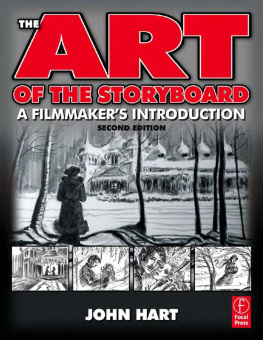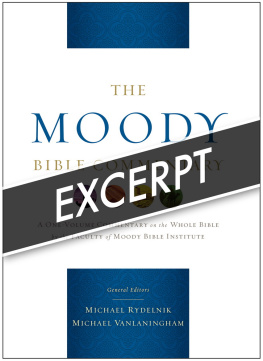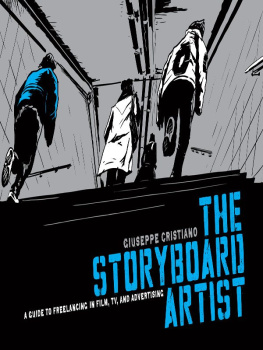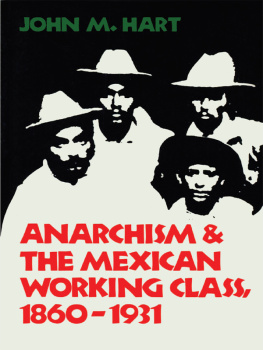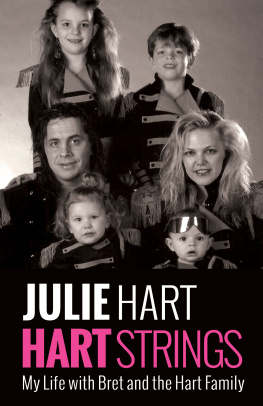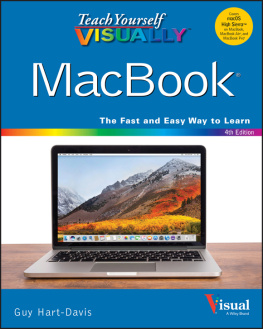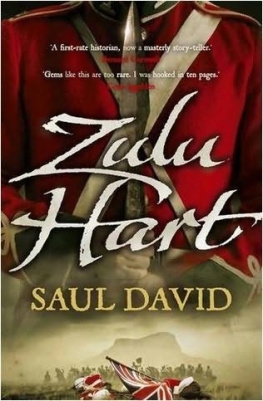John Hart - The Art of the Storyboard: A Filmmaker’s Introduction
Here you can read online John Hart - The Art of the Storyboard: A Filmmaker’s Introduction full text of the book (entire story) in english for free. Download pdf and epub, get meaning, cover and reviews about this ebook. year: 2010, genre: Home and family. Description of the work, (preface) as well as reviews are available. Best literature library LitArk.com created for fans of good reading and offers a wide selection of genres:
Romance novel
Science fiction
Adventure
Detective
Science
History
Home and family
Prose
Art
Politics
Computer
Non-fiction
Religion
Business
Children
Humor
Choose a favorite category and find really read worthwhile books. Enjoy immersion in the world of imagination, feel the emotions of the characters or learn something new for yourself, make an fascinating discovery.
- Book:The Art of the Storyboard: A Filmmaker’s Introduction
- Author:
- Genre:
- Year:2010
- Rating:4 / 5
- Favourites:Add to favourites
- Your mark:
- 80
- 1
- 2
- 3
- 4
- 5
The Art of the Storyboard: A Filmmaker’s Introduction: summary, description and annotation
We offer to read an annotation, description, summary or preface (depends on what the author of the book "The Art of the Storyboard: A Filmmaker’s Introduction" wrote himself). If you haven't found the necessary information about the book — write in the comments, we will try to find it.
The Art of the Storyboard: A Filmmaker’s Introduction — read online for free the complete book (whole text) full work
Below is the text of the book, divided by pages. System saving the place of the last page read, allows you to conveniently read the book "The Art of the Storyboard: A Filmmaker’s Introduction" online for free, without having to search again every time where you left off. Put a bookmark, and you can go to the page where you finished reading at any time.
Font size:
Interval:
Bookmark:

The Art of
the Storyboard
This page intentionally left blank

The Art of
the Storyboard
A Filmmakers Introduction
John Hart
AMSTERDAM BOSTON HEIDELBERG LONDON
NEW YORK OXFORD PARIS SAN DIEGO
SAN FRANCISCO SINGAPORE SYDNEY TOKYO
Focal Press is an imprint of Elsevier
Acquisitions Editor:
Georgia Kennedy
Publishing Services Manager:
George Morrison
Senior Project Manager:
Brandy Lilly
Assistant Editor:
David Bowers
Marketing Manager:
Marcel Koppes
Cover Design:
Alan Studholme
Focal Press is an imprint of Elsevier
30 Corporate Drive, Suite 400, Burlington, MA 01803, USA
Linacre House, Jordan Hill, Oxford OX2 8DP, UK
Copyright 2008, John Hart. Published by Elsevier, Inc. All rights reserved. No part of this publication may be reproduced, stored in a retrieval system, or transmitted in any form or by any means, electronic, mechanical, photocopying, recording, or otherwise, without the prior written permission of the publisher.
Permissions may be sought directly from Elseviers Science & Technology Rights Department in Oxford, UK: phone: (+44) 1865 843830, fax: (+44) 1865 853333, E-mail: permissions@elsevier.com. You may also complete your request online via the Elsevier homepage (http://elsevier.com), by selecting Support
& Contact then Copyright and Permission and then Obtaining Permissions.
Recognizing the importance of preserving what has been written, Elsevier prints its books on acid-free paper whenever possible.
Library of Congress Cataloging-in-Publication Data
Application submitted
British Library Cataloguing-in-Publication Data
A catalogue record for this book is available from the British Library. ISBN: 978-0-240-80960-1
For information on all Focal Press publications
visit our website at www.books.elsevier.com
07 08 09 10 11 5 4 3 2 1
Printed in the United States of America
Working together to grow
libraries in developing countries
www.elsevier.com | www.bookaid.org | www.sabre.org
Contents
Dedication vii
Acknowledgements ix
Introduction xi
Chapter 1: The Storyboards Beginnings
Tutorials
Chapter 2: The Storyboard Artist Is Part of the Preproduction Team 9
Tutorials
Chapter 3: The Storyboard Artist and the Storyboard
The Directors Vision
Tutorials
Chapter 4: Basic Components and Principles of the Storyboard
Rule of Thirds
Foreground, Middle Ground and Background
Developing Drawing Skills
Shot
Angles
Building the Storyboard
Classic Film Examples
Tutorials
Chapter 5: Adding Reality with Perspective
Perspective
Classic Film Examples
Tutorials
Chapter 6: Design, Composition and Color
Drawing Humans in Action
Human
Proportions
Light and Shadow
The Importance of Color
Black
and
White
Design and Composition
Tutorials
Chapter 7: Illustrating Action in Your Storyboard
Tutorials
v
vi Contents
Chapter 8: Light Sources and Depth of Field
Light
Sources
Depth of Field
Classic Film Examples
Tutorials
Chapter 9: The Shot, Its Dynamics and Its Function in
the Storyboard
Montage
Editing
Dynamic
Design
Tutorials
Chapter 10: Animatics: The Future of Motion Control
Sequencing
Editing
Special
Effects
A Real-World Animatic
Tutorials
Appendix A: Additional Resources
Appendix B: Glossary
Index
To my dear friend, Mary Ann Maurer, whose professionalism, humor and positive outlook made writing this book such a pleasant task.
This page intentionally left blank
Acknowledgements
I would like to acknowledge my late friend Lanny Foster, who is represented in this book.
A particular mention goes to Georgia Kennedy from Focal Press and Beth Millett, development editor, for their help and encouragement.
A majority of the artwork was drawn by me, unless otherwise noted for guest artists.
ix
This page intentionally left blank
Introduction
What goes around comes around couldnt be more applicable than to the recent announcement from Ed Catmull, president of Pixar and Disney Animation Studios, and John Lasseter, the chief creative offi cer, that they are once again returning to hand-drawn animation for their fi lm projects. Hooray!
After the success of their computer-animated project Toy Story in 1995, they closed their hand-drawing facility in 2004. They have now decided, rightly, that the charm, linear attributes and added depth of hand-drawn animation still have a strong role to play in the future of animation. We wish them well and the same to all of us artists who draw by hand!
While I was studying art in high school, I thought the greatestplace to get a job as an artist would be the Walt Disney Studios.Enthralled by the stunning visuals of Disneys Snow White and the
Seven Dwarfs, followed by Fantasia, Dumbo, Bambi,and then thedelightful Song of the South(the fi rst to combine live action actorswith cartoons), I very much wanted to be a part of Walts creativeforce. Instead I got a fellowship and went for my Masters Degreein Fine Arts. I eventually got to New York rather than Californiaand became a successful commercial artist/photographer/lecturerand author. Still, I wonder what would have happened had I beenaccepted in Walts workshops.
I later learned that most of the artists on Walts creative teamsimply worked at coloring the hundreds of thousands of cels
(acetate sheets) that comprise a full-length cartoon. Those celpainters, called in betweeners, actually went on strike a coupleof times for more money. Now, if one had the talent to get a jobin animation as an idea person, a concept sketch artist, a produc-tion design artist, a storyboard artist, or a character design person,that would have been a different story and a more creative one.As a matter of fact, concept artists are still in demand at Dream-works and Pixar, as well as all the major fi lm producers. With fi lmproduction being a collaborative art, its nice to see storyboardartists now getting acknowledged in the credits rolls on most
major motion picture releases.
Your drawing talents must be developed thoroughly in both rendering live-action images realistically and in interpreting images as called for in animated fi lms or videos. To be a storyboard artist is to illustrate the individual frames that make up xi
xii Introduction
the shots in a shooting script for animated feature fi lms, industrial fi lms or multimedia projects, and educational fi lms. All these genres use storyboards in one form or another. You are part of the preproduction team and will work with producers, production designers, directors of photography and the special effects teams, but most of your storyboard work will be done with the director, whose vision of the project will guide the entire production team.
The Art of the Storyboard II seeks to help you in the following ways:
To summarize the history and development of the storyboard and to clarify its adaptation and function as a viable visual tool for the creative team that produces live-action feature length fi lms, animation fi lms, cartoons, multimedia/industrial fi lms, videos and documentaries.
Next pageFont size:
Interval:
Bookmark:
Similar books «The Art of the Storyboard: A Filmmaker’s Introduction»
Look at similar books to The Art of the Storyboard: A Filmmaker’s Introduction. We have selected literature similar in name and meaning in the hope of providing readers with more options to find new, interesting, not yet read works.
Discussion, reviews of the book The Art of the Storyboard: A Filmmaker’s Introduction and just readers' own opinions. Leave your comments, write what you think about the work, its meaning or the main characters. Specify what exactly you liked and what you didn't like, and why you think so.

